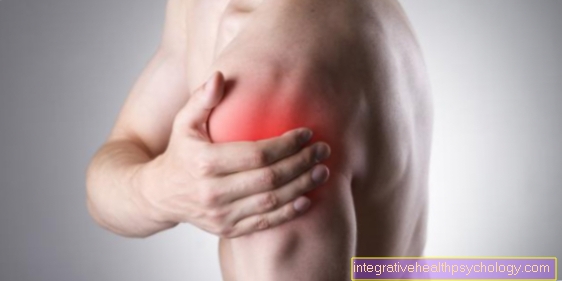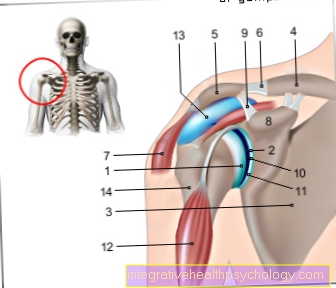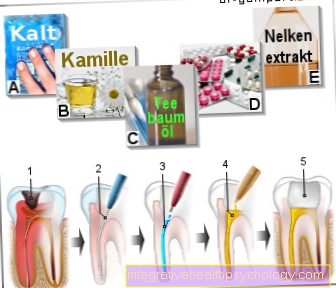Tendinitis in the shoulder
What is tendinitis?
Tendonitis of the shoulder is understood to be an inflammatory change in the tendon belonging to a specific muscle in the shoulder group, usually caused by overload.
Tendons are by definition attached to a bone and serve to stabilize the muscle. Due to the proximity to the bone, there is always friction due to movement, which can then ignite in the event of excessive or incorrect loading.
For more information on the subject, see Tendinitis

Causes of shoulder tendinitis
The most common causes of tendinitis in a muscle of the shoulder are incorrect loading or overloading of the muscle.
Overloading results from lifting heavy loads with untrained shoulder muscles. This can lead to inflammatory changes in the tendon area of one or more muscles.
Another cause of tendinitis in the shoulder girdle is incorrect loading. If certain movements (e.g. turning the arm or lifting movements) are not carried out correctly, there may be more friction in the tendon area than if the movement had been carried out in a way that was gentle on the joints and muscles. This results in an increased risk of tendinitis.
Chronic improper stress is one of the most common causes of the onset of tendinitis in the shoulder joint.
Biceps tendonitis
Biceps tendonitis is one of the most common tendinitis of the shoulder. The biceps tendon is irritated and degeneratively changed in many people at an advanced age. Much shoulder pain can be traced back to biceps tendinitis.
The biceps muscle has two tendons of origin, the long biceps tendon in particular is inflammatory. It pulls over the head of the humerus to the top of the shoulder joint. This area of the joint is located under the roof of the shoulder, the so-called "acromion". Here, many joint structures run in a very narrow space, so that stress on the muscles, calcium deposits in the joint or without any apparent cause can lead to tendon irritation.
If conservative therapies such as cooling, anti-inflammatory and restraint do not work against the tendinitis, the tendon can be surgically cut in the shoulder and sutured again on the upper arm.
Learn about the Treatment options for biceps tendonitis.
Symptoms of tendinitis of the shoulder
The first symptoms of an incipient tendinitis of the shoulder muscles are pulling pains.
Mostly they initially only occur with certain movements. The longer such inflammation has been present and the longer it may last, the more common the pain.
If the inflammation is very severe, pain can occur even at rest.
The pain is localized in the shoulder area and mostly found in the area where the muscle attaches to the upper arm. Sometimes the pain can also spread to the shoulder blade or over the upper arm to the forearm.
Read our articles on this
- Tendinitis in the arm
- Tendinitis in the upper arm
In addition to the pain caused by movement, there may also be movement restrictions in the shoulder area. Muscle movements can then no longer be carried out as usual and cause additional discomfort for the patient.
Very severe inflammation in the area of the tendons of the shoulder muscles can also be noticed by swelling. This occurs when inflammatory fluid flows into the joint area.
Appointment with a sports orthopedic specialist?

I would be happy to advise you!
Who am I?
My name is dr. Nicolas Gumpert. I am a specialist in orthopedics and the founder of .
Various television programs and print media report regularly about my work. On HR television you can see me every 6 weeks live on "Hallo Hessen".
As a passionate athlete, I have specialized in the treatment of sports diseases for professionals and hobby athletes.
The focus is therefore on diseases of the muscles, tendons and joints.
In order to be able to treat successfully in orthopedics, a thorough examination, diagnosis and a medical history are required.
In our very economic world in particular, there is too little time to thoroughly grasp the complex diseases of orthopedics and thus initiate targeted treatment.
I don't want to join the ranks of "quick knife pullers".
The aim of any treatment is treatment without surgery.
Which therapy achieves the best results in the long term can only be determined after looking at all of the information (Examination, X-ray, ultrasound, MRI, etc.) be assessed.
You can find me in:
- Lumedis - your orthopedic surgeon
Kaiserstrasse 14
60311 Frankfurt am Main
Directly to the online appointment arrangement
Unfortunately, it is currently only possible to make an appointment with private health insurers. I hope for your understanding!
Further information about myself can be found at Dr. Nicolas Gumpert
diagnosis
Through a consultation with a doctor, the doctor receives initial information about the presence of tendinitis of the shoulder muscle.
The examiner asks how long the pain has been present, whether movements cannot be carried out in the usual way and whether heavy loads were previously carried or unusual movements were carried out.
Then the shoulder joint is examined and it is checked which movements the patient reports pain. The patient is asked to move the arm forwards, backwards and to the side. Initially, the movement should be without resistance, then against resistance.
If pain is indicated in the arm movements, which is mainly found in the area of the muscle tendons, this indicates a tendinitis.
There are a few other diagnostic measures available, such as an ultrasound examination of the muscle tendon or, in cases of doubt, an MRI examination (Magnetic resonance imaging).
An ultrasound examination is very difficult to perform in the muscular area. Tear or tear of the tendon would be visible through an interruption of the otherwise light structure, an inflammation can sometimes become visible on ultrasound through a tendon thickening.
In cases of doubt and if the findings are unclear, it may be necessary for an MRI scan to show the muscle with the associated tendons.
Therapy for tendinitis of the shoulder
Tendonitis should be treated promptly after the diagnosis is made to prevent the inflammation from spreading further.
The first treatment measures are to cool the inflamed muscle attachments with an ice pack and also to consistently protect the shoulder muscles. Movements that are unfamiliar and have led to tendinitis should be avoided.
Anti-inflammatory drugs such as ibuprofen or diclofenac can also be used.
Surgical measures to treat tendinitis are rarely used. An exception is the tendon rupture or tear caused by tendinitis, which must be treated surgically if the course is severe.
Does warmth or cold help with an inflammation of the shoulder?
Tendonitis in the shoulder should never be treated with heat but with cold.
Inflammatory processes, joint effusions, swellings, pain and numerous accompanying symptoms are inhibited and alleviated by the cold. Cold leads to reduced blood flow and thus relieves inflammation. As a result, inflammatory or bloody effusions occur less often, which in turn cause severe pain.
Permanent cooling also reduces pain sensitivity.
On the other hand, warmth does the opposite. The blood flow is increased, which also increases the inflammation. With active inflammation, pain and swelling of the joint also increase.
Treatment of tendinitis with ointments
For cooling, analgesic and anti-inflammatory treatment, in addition to the tablets, there are also some pain gels and ointments available, which can either be given alongside or before tablet treatment. This includes:
- Ibuprofen in ointment form
- Diclofenac in ointment form
- Mobilat
- Kytta ointment
The above-mentioned ointments are used 2-3 times a day for about a week.
Home remedies for tendinitis
For many years, recipes for home remedies for treating tendinitis of the shoulder muscles have been carried on.
Rapid cooling of the affected area is important for all types of inflammation.
Quark wraps, for example, can be used here. For this purpose, quark that has been cooled beforehand is wrapped in a towel and then placed on the painful muscle area of the shoulder joint. A towel should either be covered over it or a kind of bandage should ensure that the cooling quark does not slip.
On the one hand, its cooling temperature has an anti-inflammatory effect. It is also assumed that the quark contains some ingredients that also have an analgesic and anti-inflammatory effect.
Quark should be used once a day during an acute inflammation until there is a clear improvement in the symptoms.
In addition to the quark wrap, ice packs can also be used, which should be wrapped in a towel and placed on the affected muscle.
There are also some tea and herbal blends that can be used successfully to treat inflammation.Prepared at home, a special mixture of lady's mantle, silver mantle, beaver noodle, wallwort, chamomile, ribwort, St. John's wort, bloodroot and arnica, when taken as a tea three times a day, can successfully reduce inflammation in the shoulder tendon area.
Learn more about the topic
- Home remedies for tendinitis
- Medicinal herbs
Schüssler salts for the treatment of tendinitis
The Schüssler salt treatment is an alternative treatment for various chronic or acute diseases. There are also some preparations that can be used in the case of tendinitis of the muscle of the shoulder.
Similar to the selection of homeopathic medicines, it is very important to carry out the patient survey very precisely in order to determine the right preparation. Concomitant symptoms such as Restlessness, insomnia or hot flashes make another Schüsslersalz necessary for the treatment of muscle inflammation than in the case of muscle tendinitis alone.
Three different preparations can be used for internal inflammation:
- Calcium fluoratum
- Ferrum Phosphoricum
- Potassium chloratum
The application should take place 3-6 times a day with 1-3 tablets each time. The tablets are not swallowed, but slowly dissolved in the mouth.
An improvement should take place a few days after the start of treatment. If there is no clear improvement or even deterioration, the treatment concept should be reconsidered.
The treatment with Schüssler salts is also ideally suited to an accompanying conventional medical treatment of tendinitis of the shoulder muscles.
Read more on the topic Schüssler salts.
Taping for tendinitis
The taping process is often used today in orthopedics and trauma surgery. Kinesio tapes are also used very frequently in sports medicine today. Especially with sports injuries in the muscular and joint areas, there are now very positive reports.
An elastic band is stuck to the affected muscle. The ligament is designed to transfer static forces that normally apply to the diseased muscle to neighboring and healthy muscles. A scientific confirmation of the healing effect of the tape, also known as kinesio tape, is still pending.
The tape should be applied to the affected muscle in the shoulder area without pulling or tension and fastened by pressure. The patient should feel a comfortable pressure in the area of the muscle. New pain after applying the tape must be clarified separately.
A kinesio tape can be left on the affected shoulder muscle for a few days to even weeks. However, it should be noted that if the symptoms fail to improve, a new treatment strategy is necessary.
You can find more on the subject under Kinesio tape
Surgery as therapy for tendinitis
An operation for tendinitis in the shoulder is necessary after the failure of conservative therapeutic approaches and the persistence of pain and movement restrictions in the shoulder. The operation is often the only sustainable treatment option for chronic shoulder problems and recurrent tendinitis.
There are two operative procedures available for this.
Many changes in the shoulder joint can be treated in a minimally invasive joint endoscopy. Tendon irritation and discomfort can be eliminated by removing parts of the shoulder roof. Severely inflamed tendons can be severed in the jointoscopy.
Open surgery can also be performed. For example, the biceps tendon can be attached to the upper arm via a 2cm long incision.
After a short rest, the patient should restore the mobility of the shoulder joint after an operation through physiotherapy. If the patient remains immobile for a long time, there is a risk of a shoulder joint stiffening.
Duration of tendinitis of the shoulder
The duration of treatment for tendinitis of a muscle in the shoulder area depends on a number of factors.
On the one hand, it is important to start protecting and cooling the affected area immediately after the diagnosis.
In addition to the cooling and gentle measures, pain and anti-inflammatory treatment with ointments and gels can greatly reduce the treatment time.
In the case of short courses, one must expect a treatment time for tendinitis from a few days to a maximum of a week. However, severe courses can also require treatment for up to 3-4 weeks.
Length of sick leave
The length of the sick leave depends heavily on the extent of the tendinitis, on the treatment strategy chosen, but also on the professional activity.
A slight tendinitis should be spared for a few weeks so that it can heal completely. Office work can often continue during conservative treatment.
In the case of severe irritation with severe pain, a sick leave can be issued for a few weeks.
After surgical treatment, shoulder tendon sutures are often followed by a long period of healing and rehabilitation. No objects should be lifted for a period of at least 6 weeks.
Even after a jointoscopy, the joint and tendons often need several weeks for the irritation and pain to subside.
Physical activity is very difficult to reconcile with tendinitis in the shoulder. In many cases, those affected have to be on sick leave for many weeks. It is not uncommon for problems with the shoulder tendons to require retraining and a change of profession.
How long should you take a break from exercising?
Tendon infections in the shoulder are often persistent diseases that can be associated with protracted pain and restricted mobility.
Slight tendon irritation can occur after exercise due to an anatomical shoulder tightness. Exercise should be paused for several weeks to allow the inflammation to subside.
If the sport is the trigger for the tendon irritation, the practice of the sport must be changed in the long term or the sport must be changed.
After an operation on the shoulder with sutures of the tendon, the joint must be relieved for at least 6 weeks so that the tendons can grow completely and stably. This is also followed by a period of rehabilitation lasting several weeks in order to slowly restore the strength and stability of the shoulder. A full load and strength training can take place after 4-6 months at the earliest.

















.jpg)











